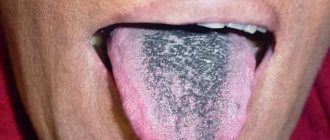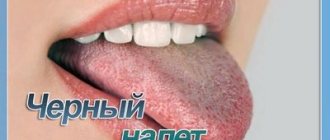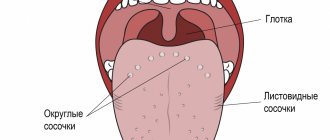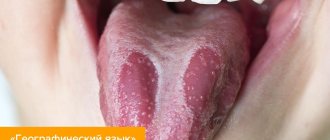A healthy human tongue should be pink, with a matte tint. A slight morning bloat, which decreases after eating, is also within normal limits. Alarm should be caused by the appearance of heavy plaque, usually resulting from an inflammatory process, or a change in the color of the back of the tongue. Sometimes you can see a blue tongue in a person, the reasons for this may be different. The most harmless of them are culinary or natural dyes; simply by eating some berries you may notice a change in the color of your tongue or lips. However, the cause is not always harmless; most often, a change in the appearance of the tongue is caused by various pathologies, including diseases of the stomach, pancreas, liver, etc.
Properties of plaque
In order to competently organize independent monitoring of the condition of the tongue to identify signs of incipient diseases on its surface, you need to know what factors and indicators you need to focus on.
Blue coating on the tongue - reasons
- The color has a fairly wide range of variations: transparent, white, yellowish, brown, gray. A red, green, crimson, or black tint may also appear. In children, it often turns out that the bright color was caused by a felt-tip pen that was in the mouth. It could be a caramel cockerel, a drink, or chewing gum. Therefore, before you panic, trying to understand why the child has a blue tongue, it is necessary to analyze the diet preceding this event. Adults experience color changes after drinking coffee, and smoking also contributes to this.
- There are several different types of plaque depending on the texture:
- dry;
- homogeneous;
- wet;
- oily;
- dense;
- loose.
- Sediment thickness is one of the key parameters. If upon visual examination it turns out that the plaque has increased in intensity and the pinkish lingual surface is practically not visible through it, control over the condition of the body should be strengthened. If the picture persists for 24 hours, it is advisable to apply for an appointment for examination.
- Localization of a spot of clearly defined deposits on a certain area of the tongue makes it possible to determine the location of the pathological focus in the body.
- The ease of removing plaque shows the degree of its pain. The normal translucent layer is peeled off during morning hygiene measures and does not appear throughout the day. Deposits that appear due to malfunctions in the functioning of specific systems are not completely removed, but after some time they become even thicker and acquire a color tone characteristic of the underlying disease.
The plaque in a healthy person is transparent and whitish in color. It does not block the view of the tissue of the tongue, is easy to clean, and has no odor. May be slightly yellowish in winter.
Associated symptoms of pathology
If the organ necessary for conversation acquires a specific tone, then most often the baby will additionally exhibit the following symptoms:
- Swelling in the mouth and face;
- Specific secretions;
- The presence of cracks, weeping ulcers;
- Soreness in the mouth when talking or eating;
- There are pimples, growths, and bumps on the surface.
If, when sticking out your tongue, not only a blue tone is visible, but also additional signs of illness, such as an unpleasant odor, then it is recommended to immediately consult a pediatrician. There is no need to prolong the baby’s condition until it becomes critical. It is better to start treatment at the first symptoms.
Reasons for the formation of blue plaque
It is advisable to collect and analyze all cause-and-effect manifestations that allow us to solve the problem of why a person’s tongue is blue, in order to notice important signals in time. This shade may appear if there is trouble in the heart area. The localization of this color on the lower surface indicates circulatory disorders aggravated by cardiopulmonary failure.
What to do if a blue coating appears on the tongue
A bluish tint on the tongue appears with scurvy. It may also reflect insufficient blood circulation. For a specialist, this may be evidence of poisoning by mercury or other heavy metals. If a blue coating on the tongue suddenly appears on the edges of the tongue located in front of the pharynx, the reasons lie in the kidney area. This kind of indicator can warn of a serious illness. Blue-black spots disappear only after the functioning of the adrenal glands in producing hormones is normalized.
The bluish upper plane becomes an accurate sign of the onset of the development of cardiovascular failure without the presence of other symptoms such as pain, a feeling of oppressive heaviness, and weakness. This will allow you to carry out a set of preventive measures to prevent a heart attack.
Possible complications
If the pathology is not detected in time and the baby lives for a long period with purple or blue color in the oral cavity, then there is a possibility of causing various complications:
- Development of heart failure;
- Problems with the respiratory system;
- Improper kidney function;
- Metabolic disorders;
- Malocclusion, which leads to the inability of the baby to close the teeth when talking or eating food;
- Problematic pronunciation of words;
- Teeth move in different directions.
At the same time, a small person may develop an inferiority complex and mental discord due to the abnormal appearance of the oral cavity.
Thus, the appearance of a bluish tint indicates health problems. To prevent such complications, you need to monitor your own child’s condition and consult a doctor in time to prescribe treatment.
Types of plaque that appears on the tongue
The variety of plaques that appear on the lingual surface has its own explanation, based on their characteristic outlines, color shades, and localization.
- The entire tongue is covered with a dense whitish coating with a simultaneous increase in temperature - an infectious disease.
- White deposits appeared in the middle of the tongue with the simultaneous appearance of cracks on the sides - pathological changes in the intestines or stomach. At the first manifestations, it is advisable to follow an easily digestible diet without fatty and salty foods. If you feel pain, you should immediately undergo an examination and obtain medical advice.
- Deposits with a white tint in the anterior area are pathological manifestations in the respiratory system, one of the causes of which may be smoking.
- White spots of deposits all over the tongue are a fungal infection that occurs from the development of dysbacteriosis. Often a consequence of uncontrolled use of antibiotics.
- The presence of a spotted plaque of red and white color is an alarming signal, since the symptoms of scarlet fever often appear. Modern medicine has effective methods for curing this insidious disease; the main thing is to seek help in time.
- The yellowish tint of deposits in small quantities should not cause concern. But with their significant thickness and intensity, we can draw a conclusion about possible inflammatory foci of the gallbladder. If at the same time you begin to worry about pain on the right side under the ribs, you should be examined to diagnose cholecystitis.
- A gray tint of plaque indicates problems in the gastrointestinal system, including increased acidity due to malfunctions that lead to dehydration and disruption of the microflora.
- The transformation of plaque into a brown crust can warn of food poisoning. If there are few deposits, it is worth analyzing the diet to identify products that can color them brownish (chocolate, coffee, cocoa, strong tea). A non-disappearing plaque like this may indicate dysbacteriosis.
The black color of the deposits should alert you, as this may be a sign of the disease entering a critical phase.
What is cyanosis
Cyanosis, or blue discoloration of mucous membranes, is an alarming symptom that accompanies many dangerous diseases. It is not an independent disease, so the natural color returns only after the cause of its appearance is eliminated.
State Definition
With cyanosis, the dog's tongue, other mucous membranes and even the skin turn blue. Depending on the severity of the condition, the color varies from gray-blue to dark purple. Such changes occur when blood circulation is impaired and the level of oxygen in the blood decreases.
Varieties
According to the degree of distribution, cyanosis is divided into local and total. In the first case, only individual areas change color, and in the second, the entire body changes color.
Depending on the location, local cyanosis is divided into 2 more types:
- central, involving the mucous membranes of the oral cavity, the area around the eyes and nose;
- peripheral, changing the color of areas distant from the heart (paws, ears).
Based on the speed of development and severity of accompanying symptoms, acute and chronic cyanosis are distinguished. The first progresses quite quickly and can lead to sudden death. The second type develops very slowly, so for a long time, cyanosis may remain the only alarming symptom.
Causes of plaque in a child
Daily examination of the internal lining of the oral cavity should become a mandatory procedure. A light thin whitish layer on the tongue that disappears after hygiene procedures or eating is normal. If the whiteness does not disappear during the day, and the layer of plaque thickens, it can be assumed that the baby has a common fungal infection, usually called thrush.
Why is there a blue coating on the tongue?
If this disease is not treated promptly, painful ulcers will develop, which will make the child worry and cry. Whitish rashes also appear during colds, disappearing after recovery. Indigestion and vomiting paralleled by a whitish coating should alert parents and prompt them to immediately obtain a qualified medical opinion, as this could be gastritis.
A child’s blue tongue requires special attention, one of the key indicators that can reflect a number of pathological problems in various important sectors of the body:
- respiratory system;
- heart (angina pectoris, arrhythmia);
- circulatory system;
- kidneys
Babies who cannot yet speak cannot express the discomfort that arises from incipient diseases, and parents do not always know how to correctly identify the child’s crying as a consequence of the pain experienced. Therefore, any signal should serve as the beginning of close observation and, if deviations are detected, immediate contact with doctors. Often, a blue tongue in an infant is associated with disorders of the nervous system, accompanied by convulsions and disruptions in the functioning of the cerebral circulation.
What to do if your tongue changes color?
If you notice a plaque of a specific tone in a child that does not go away for a long period of time, you should contact your pediatrician. Self-administration of medications is unacceptable. After the examination, the pediatrician will recommend an additional consultation with specialized specialists: a dermatologist, an infectious disease specialist, a gastroenterologist, a toxicologist, and a dentist.
Only after the examination, all doctors have the opportunity to make an accurate diagnosis and prescribe effective treatment. Typically, when a child has a purple tongue, the following therapeutic intervention is recommended:
- Problems with the digestive system - antibacterial drugs, anti-inflammatory drugs, and antispasmodics are prescribed;
- If there is a lack of vitamins in the body, the pediatrician will prescribe the required fortified complexes that will replenish the lack of nutrients in the internal organs;
- If a fungal infection is detected, antifungal drugs or antibacterial substances are required for treatment.
You should definitely make sure that your baby cleans his mouth with toothpaste that contains antibacterial ingredients. During therapy, as well as after the treatment process, it is recommended to rinse the mouth for a long period of time with a weak solution of potassium permanganate, soda-saline solution or Furacillin.
In addition to medications, you can use infusions of medicinal herbs to irrigate the oral cavity: a collection of cinnamon and cloves, calendula and medicinal chamomile.
The doctor will develop a special therapeutic diet for the baby that will prevent the condition from worsening and prevent the possibility of such a dangerous symptom from appearing in the future. It is required to give up fast food products, not to consume smoked meats, pickles and other heavy foods, as well as concentrated juices and carbonated drinks.
Ways to cleanse your tongue
To clean the surface of the tongue from the plaque that forms, it is not necessary to use complex techniques. Regular, affordable devices will do.
- The toothbrush may not have a special rough lining on the inside, oriented to directly carry out a thorough cleansing of thin normal deposits while simultaneously massaging the tongue. It is enough to walk with medium soft bristles with or without antibacterial paste in the direction from the root to the lips, as well as across the tongue to grab the side surfaces.
- You can purchase a special scraper. It is usually made of plastic, although metal or wood products are also available. Some scrapers are supplemented with special brushes.
If necessary, use reasonably accessible devices, for example, a teaspoon. You can take a bandage, wrap it around your finger, or use a clean towel or textile napkin.
Tongue hygiene is carried out only after teeth have been brushed. The movements of the scraper are directed only from the root of the tongue to its tip. First, the side with the brush is used, and then massage procedures are performed with the hard part of the device.
Blue coating on the tongue - reasons
Blue coating on the tongue
What to do if a coating appears on the tongue
Blue surface on the tongue What to do if a blue coating appears on the tongue
Dark coating on the tongue Why is there a blue coating on the tongue
Diagnostics
Consultation with a specialist is necessary for diagnostic studies and treatment. To get advice, you need to contact a therapist or pediatrician, who, if necessary, will refer you to:
- dentist;
- gastroenterologist;
- endocrinologist;
- infectious disease specialist;
- hematologist;
- dermatologist.
A detailed diagnosis will help you understand why a person’s tongue has turned blue or purple:
- Blood analysis. General analysis to determine hemoglobin, ESR, band cells. Biochemical analysis with determination of bilirubin, liver enzymes, creatinine, protein fractions. Serological blood tests for ELISA of syphilis, hepatitis. Blood test for Helicobacter antibodies, which cause gastritis.
- Coprology, stool analysis for helminthic infestations and other parasites.
- Bacteriological culture of a smear from the tongue. Sowing allows you to determine the microflora that caused the pathology, its sensitivity to antibiotics, and quantity. Also, feces and urine are taken for bacteriological culture.
- Ultrasound of the abdominal cavity, kidneys, pelvic organs.
- FGDS. Endoscopic examinations of the upper gastrointestinal tract.
- ECG. Determines the functional state of the heart, pathological changes.
Treatment of pathological processes is prescribed after finding the cause.
Visit to the veterinarian
At the appointment, the veterinarian examines the four-legged animal, listens to its chest and checks its heart function. To do this, he uses the following research:
- auscultation, detecting extraneous noise;
- pulse oximetry, which measures the degree of oxygen saturation in the blood;
- urine and blood tests to detect concomitant disorders;
- ECG, which determines heart rhythm;
- Ultrasound and x-rays that reveal pathological changes inside the lungs and heart.
The doctor may supplement the standard list with pleural puncture, bronchoalveolar lavage, or other studies. The final amount depends on the difficulty of identifying the main cause of the ailment.
What is tongue swelling, and how dangerous is it?
Edema is an increase in volume of an organ. The tongue may swell and increase in width, and also partially, for example, when a tumor-like lump forms in some place. Such conditions are extremely alarming; they may indicate the progression of a dental disease or an allergic reaction.
Note! Tongue swelling should not be confused with a slight swelling on the tip of the tongue that appears after biting or eating hot, sour foods.
Edema may also be accompanied by the following symptoms of various diseases:
- choking cough and sneezing;
- profuse lacrimation;
- rash on the surface of the face and body;
- feeling of a “lump in the throat”;
- itching in the mouth and sore throat;
- increased body temperature;
- weakness;
- difficulty swallowing;
- speech problems;
- swelling of the tissues of the oral cavity and face;
- feeling of a foreign body in the mouth, etc.
It is important! The most dangerous symptom is swelling of the tongue at its root, when the tissues block the airways, the person feels a sharp suffocation, blushes, and rolls his eyes upward. In such situations, you should urgently call an ambulance or provide emergency first aid to the patient.
Dentistry for those who love to smile
+7
Make an appointment
How language tells us about health
The state of health of a particular person, since the body is a single whole, can be judged by many parameters:
- according to skin condition,
- hair condition,
- urine color,
- the color of the tongue.
Classical Chinese medicine, in particular, speaks about this and not only it.
When visiting a doctor, each of us is asked to show our tongue; This method may seem somewhat outdated to some, but they would be deeply wrong.
While the West came up with the aphorism “tongue is given to man in order to hide his thoughts,” Eastern sages practiced methods of diagnosing diseases by the color of this muscular organ.
The doctrine of the connection between the color of the tongue and a specific disease, used in modern medicine, was developed in the traditional system of Indian medicine known as Ayurveda , as well as in:
- Ancient China,
- Tibet and other countries.
When is a blue tongue in dogs normal?
For some breeds, blueness is normal. This unusual color accompanies them from birth or appears in certain situations that are not life-threatening.
Features of brachycephalic breeds
Blue discoloration of mucous membranes in brachycephalics, which is not associated with disease, is observed not only during sleep. Other provoking factors include strong emotions. If your pet is frightened by a sudden explosion of a firecracker or is very happy about your return home, its tongue may turn blue. This change is harmless and short-term.










